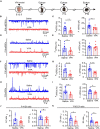Excitatory and Inhibitory Synaptic Imbalance Caused by Brain-Derived Neurotrophic Factor Deficits During Development in a Valproic Acid Mouse Model of Autism
- PMID: 35465089
- PMCID: PMC9019547
- DOI: 10.3389/fnmol.2022.860275
Excitatory and Inhibitory Synaptic Imbalance Caused by Brain-Derived Neurotrophic Factor Deficits During Development in a Valproic Acid Mouse Model of Autism
Abstract
Environmental factors, such as medication during pregnancy, are one of the major causes of autism spectrum disorder (ASD). Valproic acid (VPA) intake during pregnancy has been reported to dramatically elevate autism risk in offspring. Recently, researchers have proposed that VPA exposure could induce excitatory or inhibitory synaptic dysfunction. However, it remains to be determined whether and how alterations in the excitatory/inhibitory (E/I) balance contribute to VPA-induced ASD in a mouse model. In the present study, we explored changes in the E/I balance during different developmental periods in a VPA mouse model. We found that typical markers of pre- and postsynaptic excitatory and inhibitory function involved in E/I balance markedly decreased during development, reflecting difficulties in the development of synaptic plasticity in VPA-exposed mice. The expression of brain-derived neurotrophic factor (BDNF), a neurotrophin that promotes the formation and maturation of glutamatergic and GABAergic synapses during postnatal development, was severely reduced in the VPA-exposed group. Treatment with exogenous BDNF during the critical E/I imbalance period rescued synaptic functions and autism-like behaviors, such as social defects. With these results, we experimentally showed that social dysfunction in the VPA mouse model of autism might be caused by E/I imbalance stemming from BDNF deficits during the developmental stage.
Keywords: BDNF; E/I balance; autism; excitatory synapse; inhibitory synapse; synaptic development; valproic acid.
Copyright © 2022 Qi, Chen, Mao, Hu, Ge, Ma, Ren, Xue, Wang and Wu.
Conflict of interest statement
The authors declare that the research was conducted in the absence of any commercial or financial relationships that could be construed as a potential conflict of interest.
Figures








Similar articles
-
Male-specific alteration in excitatory post-synaptic development and social interaction in pre-natal valproic acid exposure model of autism spectrum disorder.J Neurochem. 2013 Mar;124(6):832-43. doi: 10.1111/jnc.12147. Epub 2013 Feb 3. J Neurochem. 2013. PMID: 23311691
-
Generational synaptic functions of GABAA receptor β3 subunit deteriorations in an animal model of social deficit.J Biomed Sci. 2022 Jul 11;29(1):51. doi: 10.1186/s12929-022-00835-w. J Biomed Sci. 2022. PMID: 35821032 Free PMC article.
-
5-HT7 receptor activation rescues impaired synaptic plasticity in an autistic-like rat model induced by prenatal VPA exposure.Neurobiol Learn Mem. 2021 Sep;183:107462. doi: 10.1016/j.nlm.2021.107462. Epub 2021 May 18. Neurobiol Learn Mem. 2021. PMID: 34015444
-
Molecular Pathology and Pharmacological Treatment of Autism Spectrum Disorder-Like Phenotypes Using Rodent Models.Front Cell Neurosci. 2018 Nov 20;12:422. doi: 10.3389/fncel.2018.00422. eCollection 2018. Front Cell Neurosci. 2018. PMID: 30524240 Free PMC article. Review.
-
Neuroimmune Alterations in Autism: A Translational Analysis Focusing on the Animal Model of Autism Induced by Prenatal Exposure to Valproic Acid.Neuroimmunomodulation. 2018;25(5-6):285-299. doi: 10.1159/000492113. Epub 2018 Aug 29. Neuroimmunomodulation. 2018. PMID: 30157484 Review.
Cited by
-
Abscisic Acid Rescues Behavior in Adult Female Mice in Attention Deficit Disorder with Hyperactivity Model of Dopamine Depletion by Regulating Microglia and Increasing Vesicular GABA Transporter Expression.J Neuroimmune Pharmacol. 2025 Apr 16;20(1):39. doi: 10.1007/s11481-025-10186-6. J Neuroimmune Pharmacol. 2025. PMID: 40234284 Free PMC article.
-
Mdga2 deficiency leads to an aberrant activation of BDNF/TrkB signaling that underlies autism-relevant synaptic and behavioral changes in mice.PLoS Biol. 2025 Apr 1;23(4):e3003047. doi: 10.1371/journal.pbio.3003047. eCollection 2025 Apr. PLoS Biol. 2025. PMID: 40168357 Free PMC article.
-
Three Decades of Valproate: A Current Model for Studying Autism Spectrum Disorder.Curr Neuropharmacol. 2024;22(2):260-289. doi: 10.2174/1570159X22666231003121513. Curr Neuropharmacol. 2024. PMID: 37873949 Free PMC article. Review.
-
Potential Neuroprotective Effect of Melatonin in the Hippocampus of Male BTBR Mice.Nutrients. 2024 May 28;16(11):1652. doi: 10.3390/nu16111652. Nutrients. 2024. PMID: 38892585 Free PMC article.
-
Amelioration of biased neuronal differentiation in humanized mouse model of valproic acid-induced autism by precisely targeted transcranial magnetic stimulation.Bioeng Transl Med. 2025 Jan 23;10(3):e10748. doi: 10.1002/btm2.10748. eCollection 2025 May. Bioeng Transl Med. 2025. PMID: 40385547 Free PMC article.
References
-
- Aguado F., Carmona M. A., Pozas E., Aguilo A., Martinez-Guijarro F. J., Alcantara S., et al. (2003). BDNF regulates spontaneous correlated activity at early developmental stages by increasing synaptogenesis and expression of the K+/Cl- co-transporter KCC2. Development 130 1267–1280. 10.1242/dev.00351 - DOI - PubMed
LinkOut - more resources
Full Text Sources

